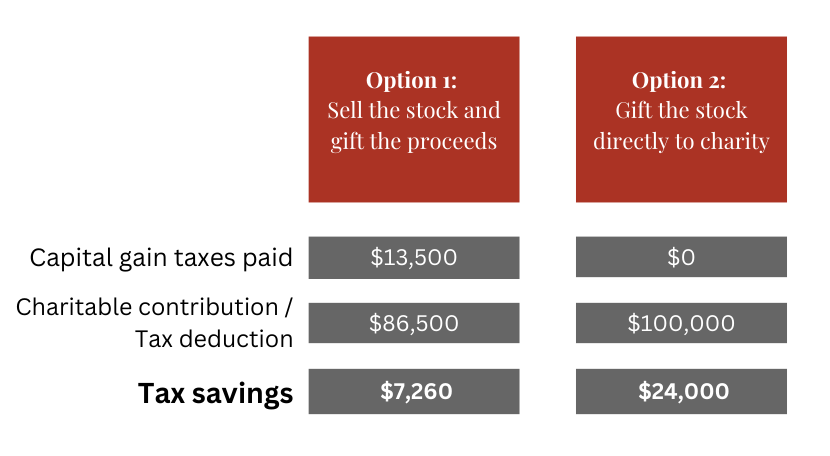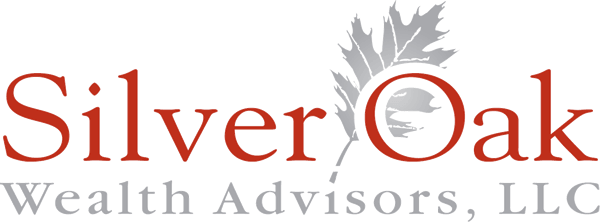As the fall season is upon us and the holiday season approaches, now is a perfect time to reflect on the year, think about people in need and organizations you want to support and honor, and make a meaningful impact. For this purpose, we have prepared four easy-to-implement, tax-efficient charitable giving strategies that not only benefit the causes you care about but also help you reduce your tax burden.
Strategy 1: Deduction Bunching
With a higher standard deduction ($13,850 for single filers or $27,700 for joint filers in 2023), fewer taxpayers are able to itemize. If that applies to you, you may choose to “bunch” your giving so you can still take a charitable deduction. Bunching means you give more in some years (to get over the standard deduction threshold) and less in other years (where you cannot itemize). This strategy allows you to have the full tax benefit without changing the overall amount of your charitable giving.
Strategy 2: Gift Appreciated Securities (instead of Cash)
|
Do you have a stock you have held for years that has grown significantly over time? If so, instead of paying capital gain tax when you sell it, you can gift the appreciated stock directly to a charity and take the full deduction of the market value on your tax return. Let’s say someone bought Stock ABC 15 years ago for $10,000, and today it is worth $100,000. If this individual wanted to gift Stock ABC to a charity, he/she could either sell it and donate the proceeds, or gift it directly. Assuming this investor is in the 24% tax bracket: |

Donating Stock ABC directly to charity would offer a win-win situation: the charity gets $13,500 more in donations, and the individual saves $16,740 more in taxes ($13,500 of capital gains tax plus $3,240 of the gift itself).
Strategy 3: Utilize a Donor Advised Fund
A simple, inexpensive way to give to charity now and over time is through a Donor-Advised Fund (DAF). DAF accounts are easy to set up at custodians such as Schwab or Fidelity with minimum costs. You can take an immediate full tax deduction in the year of making contributions and decide later how much and which charities to grant to in future years. You can also fund a DAF with appreciated stocks, non-liquid assets such as real estate, privately-held stocks and even cryptocurrency. While the money is in the DAF, any investment growth is tax-free. DAFs can also be named as beneficiaries in retirement plans and estate documents. After you are gone, your named successor can carry on the legacy of giving from your DAF account.
Strategy 4: Satisfy the Required Minimum Distribution (RMD) requirement through a Qualified Charitable Donation (QCD)
Individuals over age 70 ½ can give up to $100,000 directly to charity from their IRAs and have it count towards fulfilling their RMDs for the year. This strategy uses pre-tax dollars to give and reduces the tax burden on RMDs that would otherwise need to be taken and taxed. If one is over 70 ½ and plans to give anyway, it may make sense to give from retirement accounts instead of cash and securities in taxable accounts.
This strategy is particularly useful for those who cannot itemize their deductions. As QCDs reduce taxable income that would otherwise come from taking an RMD, the individual can both reduce top-line income and still take the high standard deduction.
Importance of Family Involvement in Charitable Gifting:
|
We believe charitable gifting also presents golden opportunities for passing on important family values to the next generations and leaving a legacy. Through intentional family discussion and involvement, parents can influence their children and grandchildren towards helping others. Studies show that children will be 81% more likely to be philanthropic in their lifetimes if the parents do so in theirs.1 Imagine at Thanksgiving dinner, every family member gets to share how they see the world and what they care about and choose where to give to make a difference. You can share stories from your own life or prompt them to think about their own values. Try asking them questions such as: |
- If you had $1,000 to give away, who would you want to give it to? Why?
- What problems in the world or society frustrate you the most? What hurts your heart right now? How could you help in that situation?
- What are you grateful for? What makes you happiest, and how can you share that with others?
By engaging other family members into lifetime giving or legacy planning, you can start – or continue – a multi-generational family story of philanthropy. If you do not have children, you can still make impacts through local community organizations by sharing your story with younger generations.
If you have any questions about these strategies and ideas, we are here to help you determine what fits your situation and can support you in implementing these solutions to maximize your charitable impact and fulfill your heartfelt wishes.
1 Study of High Net Worth Philanthropy, U.S. Trust, 2018 |
